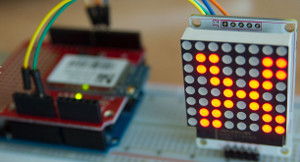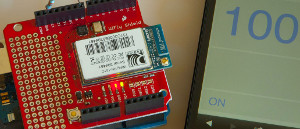Without too much fanfare another Internet-of-Things platform has been introduced to the market which deserves some exploration. Called XOBXOB (pronounced “zob-zob”), it is claimed to provide users with an easy to use Internet platform for building distributed networks of devices that communicate with the Internet and with each other.
XOBXOB is aimed particularly at ease of use in conjunction with Arduino or Arduino-compatible platforms, providing a cloud service for “Simple Internet for Things” in conjunction with the Arduino environment.
XOBXOB can be used in conjunction with an Arduino or compatible and Ethernet Shield, a Roving Networks WiFly module, or any Arduino-compatible hardware connected to a PC. If you don’t have any appropriate Ethernet or Wi-Fi connected hardware suitable for use with XOBXOB then the Arduino can use a downloadable “Connector”.
This is a small application from XOBXOB, available for Windows, Linux or OSX, which provides Internet connectivity between the XOBXOB service and your microcontroller board via your PC, without requiring the use of embedded Ethernet or Wi-Fi hardware.
Getting started with XOBXOB requires a physical thing, like an Arduino, or a virtual thing, like a web browser running on a smartphone or PC. Although you can get started with only one thing, XOBXOB is more interesting to get started with if you have multiple things that can talk to each other via XOBXOB, such as both an Arduino and a smartphone.
Although it’s easiest to get started with XOBXOB using an Arduino, you do not have to use an Arduino. More experienced users can use XOBXOB’s RESTful API to implement XOBXOB connectivity for essentially any device that can connect to the Internet.
Furthermore, the XOBXOB team continues to work on libraries and sample projects to make it easy to use other popular embedded computing platforms and single-board computers such as BeagleBone and Raspberry Pi.
Once you’ve got suitable hardware, you can register for an account on the XOBXOB website and get the private API token from your XOBXOB dashboard. You’ll also need to download and install the XOBXOB Arduino library.
XOBXOB makes it very easy to get started by including simple examples in the XOBXOB Arduino sketch library, such as a basic Internet-connected LED control program, using the XOBXOB service to control a LED (or any digital device) remotely via the Web.
These basic examples provide a quick way to test the network connectivity between your Arduino, your LAN and the Internet. When getting started with a XOBXOB Arduino sketch, remember that you’ll need to put your private XOBXOB API token (available via the XOBXOB dashboard) and the MAC address of your Ethernet device into the Arduino sketch.
There are three different libraries to use, depending on whether you’re using an Ethernet-equipped Arduino, a WiFly-equipped Arduino, or an Arduino connected to a PC with the Connector software.
With this example, you can then use the on/off panel on the XOBXOB dashboard to set the state of the LED on or off, and then click “SET”. You can also do a “GET” to retrieve the status of the digital output, which is useful if multiple users are controlling the state of the system. These kinds of set and get methods are likely to be familiar to users with some Java or other object-oriented programming experience.
More advanced example code is also included, for example to allow you to demonstrate Internet-connected control of a MAX7219-based 64-pixel LED display via the XOBXOB cloud service.
You can also send serial data to the microcontroller, for example, from a smartphone or any device with a web browser, anywhere in the world, connecting your physical world to the web in a very accessible way.
These more advanced examples are still simple to use and fast to get started with – you can use the XOBXOB service and XOBXOB’s sample projects and resources to get an elaborate demonstration of cloud-based control of a LED display or other device up and running in minutes.
The functions of the XOBXOB Arduino libraries are well documented in XOBXOB’s Arduino library guide, making it easy to move past the basic examples provided and implement XOBXOB connectivity for your own specific application.
For example, your Arduino code can control whatever you want to happen in the handler that corresponds to the ON/OFF button being used on the XOBXOB dashboard. XOBXOB works by creating small “mailboxes” called XOBs. To control additional devices from your XOBXOB dashboard, you create a new device in the dashboard, and give it a name.
Your Arduino code then needs to request that XOB by name in the “requestXOB” function, meaning that it will respond to that device on the cloud side when needed – multiple different devices can be independent of each other, or they can talk to each other if you like.
Your physical things can send and receive messages through a XOB, and by sharing XOBs, things can send messages to each other. In this regard, XOBXOB is a true Internet-of-Things platform, allowing machine-to-machine communications with packets of data travelling between connected devices.
The machine-to-user control and communications provided by the Web interface is only a part of the overall system – it is not just providing Web-based datalogging of temperature or other data collected from the hardware devices, it also provides the capability for machine-to-machine communications and basic bidirectional control of the hardware from the Web service.
Although the platform is skewed towards the Arduino-compatible hardware platform, this is still perfectly acceptable for a wide range of products and allows for rapid development due to the open-source nature of the platform. This allows us to bring your IoT product ideas to market in a much shorter period of time.
To find out if XOBXOB is an ideal fit, or to explore other options to solve your problems – join us for an obligation-free and confidential discussion about your ideas and how we can help bring them to life – click here to contact us, or telephone 1800 810 124.
LX is an award-winning electronics design company based in Sydney, Australia. LX services include full turnkey design, electronics, hardware, software and firmware design. LX specialises in embedded systems and wireless technologies design.
Published by LX Pty Ltd for itself and the LX Group of companies, including LX Design House, LX Solutions and LX Consulting, LX Innovations.


